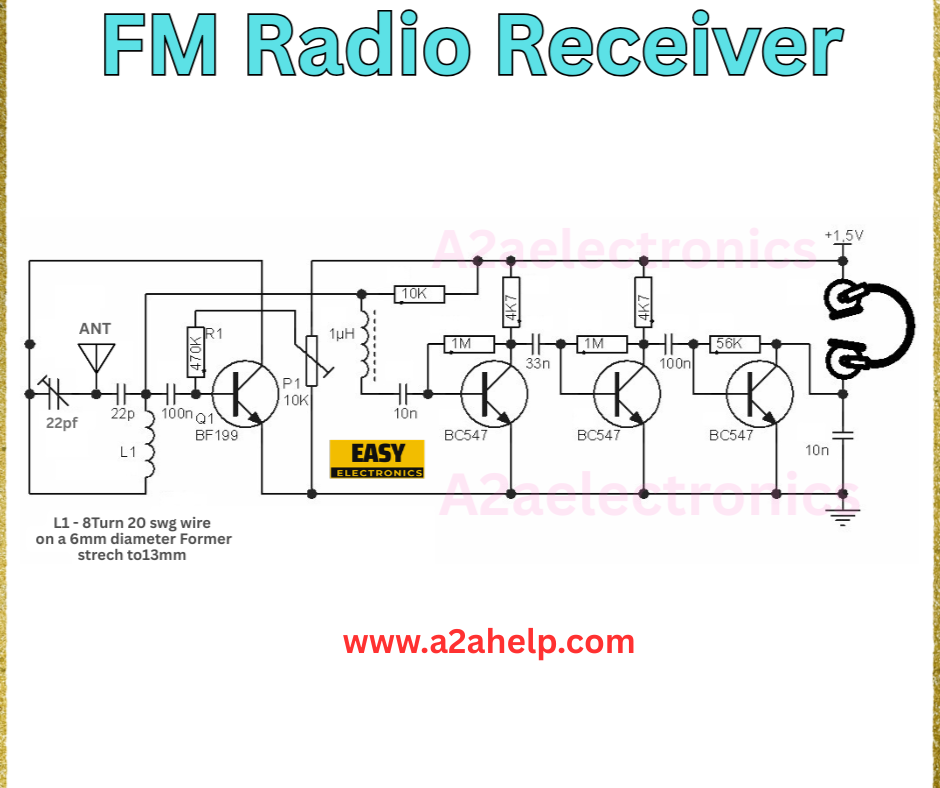Are you fascinated by the world of radio frequencies and eager to build your own FM radio receiver? This DIY project is perfect for electronics enthusiasts, hobbyists, and learners looking to dive into the exciting realm of RF circuits. In this detailed guide, we’ll walk you through constructing a simple yet effective FM radio receiver using basic components. Let’s get started!
What is an FM Radio Receiver?
An FM radio receiver captures frequency-modulated (FM) signals broadcast over the airwaves and converts them into audible sound. FM radio offers superior sound quality compared to AM due to its resistance to interference. Building one from scratch is a rewarding way to understand radio technology and enhance your electronics skills.
Components You’ll Need
To build this FM radio receiver, gather the following parts:
- Antenna: A simple wire or dipole antenna to capture FM signals.
- BF199 Transistor: Acts as the RF amplifier.
- BC547 Transistors: Used in the audio amplification stages (3 units).
- 22pF Capacitors: For tuning and coupling.
- 10nF and 100nF Capacitors: For filtering and stabilization.
- 1µH Inductor (L1): Part of the tuned circuit (wind 8 turns of 20 SWG wire on a 6mm former, stretch to 13mm).
- 10kΩ and 56kΩ Resistors: For biasing and load.
- 1MΩ Resistor: Sets the operating point.
- Potentiometer (10kΩ): Adjusts the tuning.
- Headphones: For audio output.
- 9-12V Power Supply: To power the circuit.
- Breadboard and Connecting Wires: For assembly.
- Multimeter: To troubleshoot connections.
Circuit Diagram and Assembly
The circuit diagram in the image provides a clear blueprint for assembling the FM radio receiver. Follow these steps:

Step 1: Set Up the Antenna and RF Stage
- Connect the antenna to the collector of the BF199 transistor via a 22pF capacitor.
- Attach a 10kΩ resistor (R1) from the collector to the positive supply.
- Link the emitter to ground through another 22pF capacitor.
- Connect the 1µH inductor (L1) and 10kΩ potentiometer in parallel with the base, tuning the circuit.
Step 2: Build the IF and Audio Stages
- Couple the collector of BF199 to the base of the first BC547 transistor via a 10nF capacitor.
- Use a 56kΩ resistor from the collector to the supply and a 10kΩ resistor from the base to ground.
- Connect the second and third BC547 transistors in a similar configuration, with 100nF capacitors for coupling between stages.
- Link the final stage to the headphones via a 10nF capacitor.
Step 3: Power and Ground Connections
- Connect the positive supply (9-12V) to the appropriate points as shown.
- Ensure all ground points are common.
- Verify capacitor polarities and transistor orientations.
How It Works
The BF199 transistor amplifies the weak FM signals captured by the antenna. The tuned circuit (L1 and potentiometer) selects the desired frequency. The BC547 transistors amplify the intermediate and audio frequencies, converting the signal into sound output through the headphones. Adjusting the potentiometer tunes the receiver to different FM stations.
Testing and Troubleshooting
- Power On: Apply 9-12V and adjust the potentiometer to scan for stations.
- Check Audio: If no sound, ensure the antenna is properly connected and the supply voltage is stable.
- Fine-Tune: Stretch or compress L1 slightly to improve reception.
Benefits of Building an FM Radio Receiver
- Educational: Gain hands-on experience with RF and audio circuits.
- Cost-Effective: Uses affordable, readily available components.
- Portable: Ideal for small-scale listening with headphones.
Safety Tips
- Handle transistors carefully to avoid static damage.
- Use a regulated power supply to prevent voltage spikes.
- Double-check all connections before powering on.
Conclusion
Building an FM radio receiver is a fantastic way to explore electronics and enjoy the satisfaction of creating your device. With the right components and careful assembly, you can tune into your favorite FM stations. Visit www.a2ahelp.com for more electronics projects and tutorials. Start your radio adventure today!
